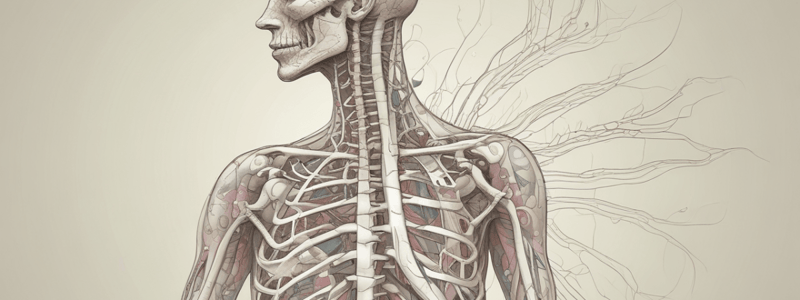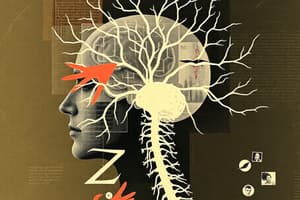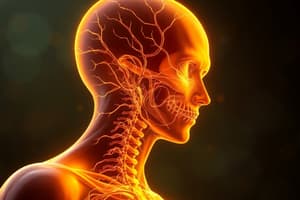Podcast
Questions and Answers
What is the significance of a positive Babinski reflex in humans older than 1½ years?
What is the significance of a positive Babinski reflex in humans older than 1½ years?
- It indicates normal development
- It indicates weakness in the legs
- It indicates destruction of corticospinal fibers (correct)
- It indicates a healthy nervous system
The corneal reflex is mediated by the sixth cranial nerve.
The corneal reflex is mediated by the sixth cranial nerve.
False (B)
What is the name of the reflex that involves drawing in of the abdominal wall in response to stroking the side of the abdomen?
What is the name of the reflex that involves drawing in of the abdominal wall in response to stroking the side of the abdomen?
Abdominal reflex
In infants, the Babinski reflex is present until approximately __________ years of age.
In infants, the Babinski reflex is present until approximately __________ years of age.
Match the reflex with its corresponding cranial nerve(s):
Match the reflex with its corresponding cranial nerve(s):
What is the name of the swelling in the dorsal root of each spinal nerve?
What is the name of the swelling in the dorsal root of each spinal nerve?
The lumbar, sacral, and coccygeal nerve roots descend from the point of origin at the lower end of the spinal cord before reaching the intervertebral foramina of the respective vertebrae.
The lumbar, sacral, and coccygeal nerve roots descend from the point of origin at the lower end of the spinal cord before reaching the intervertebral foramina of the respective vertebrae.
What is the term for the complex networks formed by the ventral rami of most spinal nerves through subdividing and then joining together to form individual nerves?
What is the term for the complex networks formed by the ventral rami of most spinal nerves through subdividing and then joining together to form individual nerves?
The region of skin surface area supplied by afferent (sensory) fibers of a given spinal nerve is called a _______________.
The region of skin surface area supplied by afferent (sensory) fibers of a given spinal nerve is called a _______________.
Match the following cranial nerves with their functions:
Match the following cranial nerves with their functions:
How many pairs of spinal nerves are connected to the spinal cord?
How many pairs of spinal nerves are connected to the spinal cord?
All cranial nerves arise from locations on the cerebrum.
All cranial nerves arise from locations on the cerebrum.
What is the term for the skeletal muscle or muscles supplied by efferent (motor) fibers of a given spinal nerve?
What is the term for the skeletal muscle or muscles supplied by efferent (motor) fibers of a given spinal nerve?
The sympathetic chain is formed by the splitting and rejoining of autonomic fibers from the _______________.
The sympathetic chain is formed by the splitting and rejoining of autonomic fibers from the _______________.
What is the function of the trochlear nerve (CN IV)?
What is the function of the trochlear nerve (CN IV)?
The trigeminal nerve (CN V) has two branches.
The trigeminal nerve (CN V) has two branches.
What is the function of the vestibulocochlear nerve (CN VIII)?
What is the function of the vestibulocochlear nerve (CN VIII)?
The accessory nerve (CN XI) was once thought to be an “accessory” to the _______________________ nerve.
The accessory nerve (CN XI) was once thought to be an “accessory” to the _______________________ nerve.
Match the following cranial nerves with their functions:
Match the following cranial nerves with their functions:
The hypoglossal nerve (CN XII) is composed of only motor fibers.
The hypoglossal nerve (CN XII) is composed of only motor fibers.
The Roman numerals I-XII are used to number the cranial nerves in a sequence from _______________________.
The Roman numerals I-XII are used to number the cranial nerves in a sequence from _______________________.
What type of reflex is the knee jerk reflex?
What type of reflex is the knee jerk reflex?
What is the Babinski sign?
What is the Babinski sign?
The ankle jerk reflex is a spinal cord reflex.
The ankle jerk reflex is a spinal cord reflex.
Study Notes
Spinal Nerves
- There are 31 pairs of spinal nerves connected to the spinal cord, numbered by the level of vertebral column at which they emerge from the spinal cavity.
- The spinal nerves are mixed nerves, carrying both sensory and motor fibers.
- The nerves are named by their level of emergence:
- Cervical nerve pairs (C1-C8)
- Thoracic nerve pairs (T1-T12)
- Lumbar nerve pairs (L1-L5)
- Sacral nerve pairs (S1-S5)
- One coccygeal nerve pair
- The lumbar, sacral, and coccygeal nerve roots descend from the lower end of the spinal cord before reaching the intervertebral foramina of the respective vertebrae, where they emerge as spinal nerves.
Structure of Spinal Nerves
- Each spinal nerve attaches to the spinal cord by a ventral (anterior) root and a dorsal (posterior) root.
- The dorsal root ganglion is a swelling in the dorsal root of each spinal nerve.
- Spinal nerves form large branches called rami after emerging from the spinal cavity.
- The dorsal ramus supplies somatic motor and sensory fibers to smaller nerves that innervate the muscles and skin of the posterior surface of the head, neck, and trunk.
- The ventral ramus is more complex, with autonomic motor fibers splitting off and heading toward a ganglion of the sympathetic chain.
Nerve Plexuses
- Plexuses are complex networks formed by the ventral rami of most spinal nerves.
- The ventral rami subdivide and then join together to form individual nerves.
- The individual nerves that emerge contain all the fibers that innervate a particular region of the body.
- There are four major kinds of plexuses:
- Cervical plexus
- Brachial plexus
- Lumbar plexus
- Sacral plexus and coccygeal plexus
Dermatomes and Myotomes
- A dermatome is the region of skin surface area supplied by afferent (sensory) fibers of a given spinal nerve.
- A myotome is the skeletal muscle or muscles supplied by efferent (motor) fibers of a given spinal nerve.
Cranial Nerves
- There are 12 pairs of cranial nerves arising from locations on the underside of the brain.
- Cranial nerves primarily serve the head and neck.
- The first pair of cranial nerves originates in the cerebrum, while the remainder originate from the brainstem.
- Cranial nerves are numbered in order, usually revealing the structures they control, and are written in Roman numerals.
Cranial Nerve Functions
- Olfactory nerve (CN I): carries information about the sense of smell
- Optic nerve (CN II): carries visual information from the eyes to the brain
- Oculomotor nerve (CN III): regulates eye movement and light entry
- Trochlear nerve (CN IV): controls the superior oblique muscles of the eye
- Trigeminal nerve (CN V): carries sensory information from the skin and mucosa of the head and teeth
- Abducens nerve (CN VI): controls lateral rectus muscles of the eye
- Facial nerve (CN VII): regulates facial muscles, salivary glands, and taste buds
- Vestibulocochlear nerve (CN VIII): transmits equilibrium and hearing information
- Glossopharyngeal nerve (CN IX): supplies fibers to the tongue, pharynx, and carotid sinus
- Vagus nerve (CN X): supplies fibers to the pharynx, larynx, trachea, heart, and various organs
- Accessory nerve (CN XI): innervates muscles of the abdomen, pharynx, and larynx
- Hypoglossal nerve (CN XII): controls the muscles of the tongue
Reflexes
- Reflexes are rapid, automatic responses to stimuli.
- Knee jerk reflex (patellar reflex): extension of the leg in response to tapping the patellar ligament
- Ankle jerk reflex (Achilles reflex): extension of the foot in response to tapping the Achilles tendon
- Plantar reflex: plantar flexion of all toes and a slight turning in and flexion of the anterior part of the foot
- Corneal reflex: winking in response to the cornea being touched
- Abdominal reflex: drawing in of the abdominal wall in response to stroking the side of the abdomen
Studying That Suits You
Use AI to generate personalized quizzes and flashcards to suit your learning preferences.
Description
This quiz covers the spinal nerves, their connections to the spinal cord, and their classification. Learn about the different types of nerve pairs and their functions.




